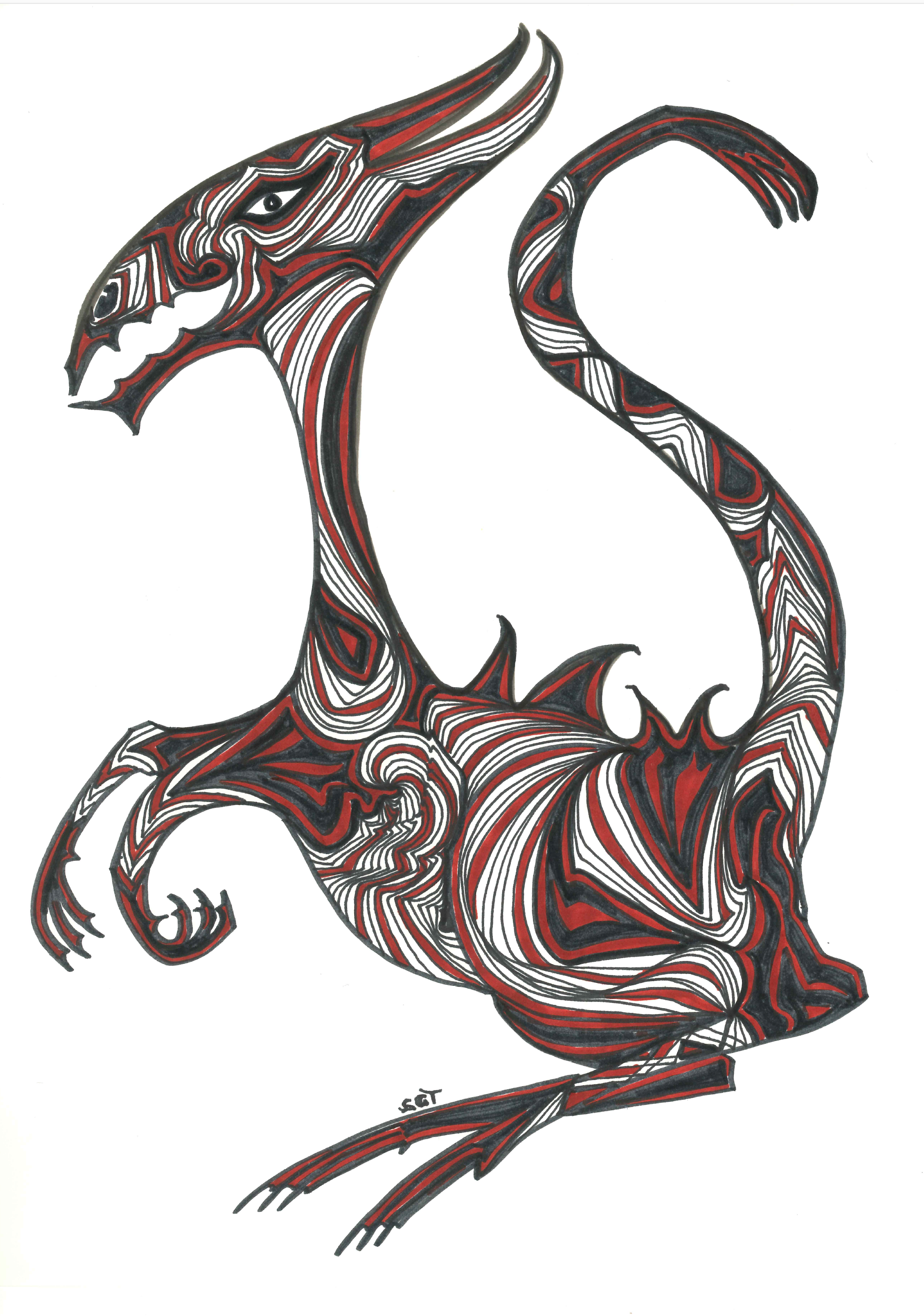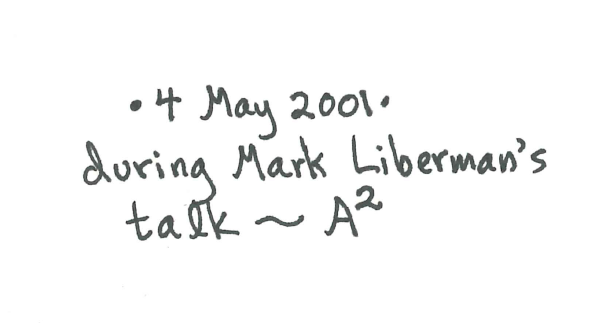Interfaces and Interactions
« previous post | next post »
Going through a box of papers from years ago, I found one of Sally Thomason's famous doodles:

I've set it aside to be framed and hung, facing the Haida frog that was a gift a decade earlier from Nicola Bessel.
The doodle was in a folder containing the plastic overhead-projector transparencies from a talk I gave at the University of Michigan in 2001, along with the program for the event, which included two days of talks under the general heading of "Interfaces and Interactions in the Future of Linguistics". Verifying the connection is Sally's note on the reverse of the image:

I scanned the slides, out of historical curiosity — it's interesting to see how things have developed since the long-ago era of the Overhead-Projector Culture. Which followed the Chalkboard Culture, the Slide Carousel Culture, and the Handout Culture, and preceded the Digital Projector Culture.
The transitions between these eras were sometimes tricky. Early in the Overhead Projector period, when the plastic transparencies were the norm in industry but not yet widely used in academia, I gave at talk at the University of Toronto. They didn't have an overhead projector, and I was ready to fall back on the chalkboard, when someone came up with an "Opaque Projector", which was a large metal box about the size of a washing machine, in which a very bright internal light source illuminated the contents of the box and projected the image through a set of lenses onto a remote screen.
It worked fine until halfway through the first slide, when the projected image showed the transparency melting and catching fire.
Dick Margulis said,
July 7, 2021 @ 7:41 am
Meanwhile, outside of academia for the most part:
The overhead projector was the cool new tech in high school (class of 1964), which still had slate chalkboards. (The transparency was Kodak X-ray film base recycled from hospitals that had recovered the silver.)
Slide projectors had been around a few years, but the Kodak Carousel came along a couple years later.
Harvard Graphics, beginning in 1986, converted files sent to them to slides for projection. PowerPoint came along in 1987, as did the first (expensive) digital projector.
You were still using overhead transparencies in 2001 in your environment, but by about 1990, in the tech world, at least, an overhead projector was something gathering dust in a storeroom or dropped off at the scrap metal dealer. By 1995, give or take, every department had a digital projector, and by 2000, every sales rep had one assigned to them.
bks said,
July 7, 2021 @ 8:33 am
Roger Penrose still uses overhead transparencies in his talks.
https://youtu.be/LPSzTcyXU7o
(2019)
mg said,
July 7, 2021 @ 11:12 am
I remember always making both transparencies and slides for my conference presentations so I'd be prepared in case a projector broke and I had to switch modalities.
D.O. said,
July 7, 2021 @ 1:50 pm
Yes, but what is A-squared?
Jerry Friedman said,
July 7, 2021 @ 1:51 pm
Opaque projectors, along with overhead projectors and film strips, were staples of my elementary-school career in the late '60s and early '70s.
Daniel Barkalow said,
July 7, 2021 @ 4:57 pm
Reminds me of Negativland's "A Loop Which Goes On Forever" live performance, which involved projecting a film that was being melted by the projector.
Sally Thomason said,
July 7, 2021 @ 6:13 pm
D.O. — A-squared (or simply A2) is the locals' way of abbreviating Ann Arbor. (I always date & locate my doodles.)
Mark — That was a *wonderful* talk you gave at U Michigan in 2001! For years I had a copy of your one-page handout on the future of linguistics posted beside my office door.
Rick Rubenstein said,
July 8, 2021 @ 12:33 am
The art department in my small-but-rather-upscale public high school in the mid-to-late 1980s had (probably quite unusually) an opaque projector, which was a marvel. It certainly did get alarmingly hot, though.
Jon said,
July 8, 2021 @ 12:36 am
I remember one conference where the carousel kept jamming. One speaker gave up on it and distributed his slides among the front row, and asked people to pass them on. People were holding them up to light and squinting at them. I was in the fourth row, and they never got to me.
Fred Bennett said,
July 8, 2021 @ 2:10 am
I am surprised "epidiascope" is missing from this discussion. "Opaque Projector" is a name I have never met despite being in my eighties.
The epidiascope at school had a thick glass block which went over the document being projected and acted as an heat sink.
Philip Taylor said,
July 8, 2021 @ 4:10 am
Thank you, Fred. I was certain that we did not have "opaque projectors" (by that name) in the UK, but could not remember what we did call them. Now I know !
D.O. said,
July 8, 2021 @ 10:47 am
Sally Thomason, thank you!
Amanda Adams said,
July 8, 2021 @ 6:10 pm
Wow! Elizabeth Zwicky has someone to look up to!
KeithB said,
July 9, 2021 @ 8:56 am
When I was a juror in a case they kept calling the opaque projector an "Elmo", I guess because that was a popular manufacturer.
I went to a seminar by Eli Brookner:
https://ieee-aess.org/contact/eli-brookner
He used an overhead projector and all I can say was that he actually animated the slides.
He would scribble on them, and every time he mentioned that phased-array radar installations tended to catch fire, he would slap on a picture of the FPS-85 on fire and scribble red marker on it.
He would also out of the blue talk about "Travelling-Wave tubes" and slap on a slide of a vacuum tube carrying a surfboard.